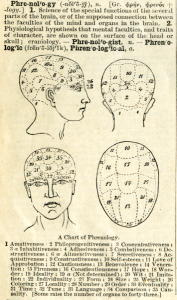Physiognomy (sometimes referred to as anthroposcopy) is the assessment of a person’s character from the face and external appearance. Phrenology is the study of the skull in relationship to an individuals character.

References to face reading were first recorded in early Greek poetry and philosophers who referred to using the facial features and outward appearance to ascertain the individuals character or personality. This subject was popular and was even taught in universities in England until 1531 when Henry VIII of England outlawed the practice along with Palmistry.
Physiognomy rose again in popularity during the 18th-19th century and there are still people who study, teach and practice the art today, including Yoshito Minzo, a physiognomist who was employed by the Imperial Japanese Naval Aeronautics Department examining candidates to become successful qualified pilots with 80% accuracy for the Naval Air Corps from 1936 to 1945. More recently a physiognomical analysis of the North Korean leader Kim Jong-Un was published in the South Korean news agency Yonhap in 2011.
Whilst these two subjects are not entirely combined, they often appear together in journals as pseudoscientific, however, they have both been influential in the fields of psychiatry and modern neuroscience. Aristotle was one of the early philosophers to record his studies on the brains mental abilities, but it was not until the late 1700’s to mid 1800’s when the German physician Franz Joseph Gall started lecturing on organology, that his collaborator Johann Gaspar Spurzheim popularized the term Phrenology.
Interestingly, both of these studies are still used in some form by the Police and criminologists
PHRENOLOGY VIDEOS
PHYSIOGNOMY VIDEOS
Related Links:
Physiognomy at Wikipedia
Phrenology at Wikipedia
BBC News: Womens traits written on face
